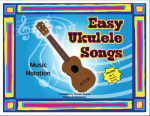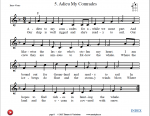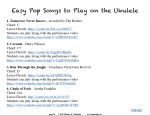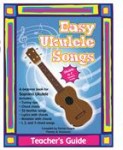Ukulele in the Classroom – Part One
Ukulele in the Classroom – Part 1
By Denise Gagne
If anyone was listening to Q on CBC radio Feb. 27, 2015 they heard the great debate between the ukulele and the recorder in the elementary classroom. CBC interviewed me in defense of the recorder, and James Hill in defense of the ukulele. Both of us were in agreement that if schools have funding, time, space that teaching BOTH the ukulele and the recorder would be the best possible option.
The recorder is inexpensive, it doesn’t have to be tuned every 10 minutes, and it’s relatively easy to learn. When played well, the recorder is a beautiful instrument and there is authentic music written for recorder by Bach, Handel, Telemann and Vivaldi! I play in an adult recorder consort in Red Deer and play bass, tenor, alto, soprano and sopranino and really enjoy it. I think that students who learn to play recorder have an easy transfer from recorder to any woodwind instrument. Students who use my recorder method, The Recorder Resource or the Learn and Play Recorder App are successful, because it’s carefully sequenced.
One of the benefits of teaching ukulele is that it can be used as a melodic or harmonic instrument. Students can play and sing at the same time. Students in Grade 4-5 can become reluctant singers, but with a ukulele or a guitar in hand, they are often motivated to sing while they learn to play.
There are four main sizes of ukulele: soprano, concert, tenor and baritone. My preference is to use the concert size in the classroom. The soprano is quite small and the frets are really close together. Many children in Grade 5-6 have bigger hands than I do, and I find it hard to play some of the chords on the soprano uke because the frets are so small. The concert is not a lot more expensive, and it has a fuller, richer sound. If I’m going to spend the money for a baritone uke, I’d just as soon get a set of classroom guitars.
When teaching ukulele, the biggest frustration is tuning the ukes. Spend the money to get a better quality instrument that stays in tune. I recently used West Music’s Kala wooden ukulele, and it held it’s tuning well and sounded good. For $44.95 US, it was a nice uke. In Canada, Themes sells a Vidar concert ukulele that is a great quality instrument with excellent quality tuning pegs. ($65-85 depending on quantity) If you pay $30 for a uke, you’ll have tuning problems – pay a little more and get an instrument that stays in tune. I can’t believe there are still some vendors selling ukuleles with wooden tuning pegs – avoid them! Get a uke with good machine heads.
 If you store your ukuleles on the classroom wall (see pinterest for ideas) it’s easy for you to tune them before school. If that’s not possible, have the students line up and tune each of them. I do the tuning by ear – we have a ukulele tuner at www.musicplayonine.com and I play the “G” over and over, tuning each uke. I can do a class set in about 5 minutes. One problem that can occur is kids playing or talking in the line-up. I can’t tune the uke if I can’t hear. I tune the first student’s uke, then that student becomes the “monitor” and writes names on the board of anyone who’s making sound. The noise makers have to come in at recess or lunch for a minute of “quiet practice.” I set a timer and they have to be completely silent for 60 seconds. They make a sound, the timer starts again. They don’t usually need quiet practice more than once – it’s effective.
If you store your ukuleles on the classroom wall (see pinterest for ideas) it’s easy for you to tune them before school. If that’s not possible, have the students line up and tune each of them. I do the tuning by ear – we have a ukulele tuner at www.musicplayonine.com and I play the “G” over and over, tuning each uke. I can do a class set in about 5 minutes. One problem that can occur is kids playing or talking in the line-up. I can’t tune the uke if I can’t hear. I tune the first student’s uke, then that student becomes the “monitor” and writes names on the board of anyone who’s making sound. The noise makers have to come in at recess or lunch for a minute of “quiet practice.” I set a timer and they have to be completely silent for 60 seconds. They make a sound, the timer starts again. They don’t usually need quiet practice more than once – it’s effective.
Chords or Picking? What should you teach the students? Should you teach them to chord and sing, or should you teach them to read and play melodies. Some methods teach both chords and melodies at the same time, but I’ve found that children love being able to strum and sing along on the very first day. ALL children can be successful if you sequence carefully.
In my book, Easy Ukulele Songs, I’ve got 15 one chord songs, and then 15 easy two chord songs. Changing chords is the big challenge, so if you start with one chord songs, everyone is able to keep up. When I first start two chord songs, I divide the class in half, and have one half play one chord and the other half the other. There may be a few students who can change chords, and I encourage them to do the change if they can. I do a lot of practicing the chord changes before asking the class to try – play 8 C chords, rest for 4, then play 8 F chords. I have them try doing the change with their eyes closed to help develop the tactile memory.
 To introduce the ukulele, Easy Ukulele Songs includes a PDF, “Introduction to the Ukulele.” It illustrates a brief history of the uke, the parts of the ukulele, how to hold, how to strum, how the fingers are numbered, how to read a chord chart, and how to play the first chord, C. Simply project and read it through with the students.
To introduce the ukulele, Easy Ukulele Songs includes a PDF, “Introduction to the Ukulele.” It illustrates a brief history of the uke, the parts of the ukulele, how to hold, how to strum, how the fingers are numbered, how to read a chord chart, and how to play the first chord, C. Simply project and read it through with the students.
 Easy Ukulele Songs includes a projectable PDF of the lyrics and chords AND the song notation and chords. The PDF is big, clear, easy to read and we’ve embedded the audio. You can play with or without accompaniment tracks. I like to use the audio for songs that are less familiar, and have the kids play the songs that are more well known.
Easy Ukulele Songs includes a projectable PDF of the lyrics and chords AND the song notation and chords. The PDF is big, clear, easy to read and we’ve embedded the audio. You can play with or without accompaniment tracks. I like to use the audio for songs that are less familiar, and have the kids play the songs that are more well known.
 Pop Songs: In the Projectable PDFs we also included links to pop songs on YouTube that are easy to play! Lime in the Coconut uses just the C7 chord! It’s a super easy chord, and your students will be able to play a pop song on the very first day. There are 30+ pop songs that your students will enjoy playing along with. Remember that with YouTube sometimes links disappear – some of our Beatles songs got pulled from YouTube, but you can usually search the title and find a substitute.
Pop Songs: In the Projectable PDFs we also included links to pop songs on YouTube that are easy to play! Lime in the Coconut uses just the C7 chord! It’s a super easy chord, and your students will be able to play a pop song on the very first day. There are 30+ pop songs that your students will enjoy playing along with. Remember that with YouTube sometimes links disappear – some of our Beatles songs got pulled from YouTube, but you can usually search the title and find a substitute.
This is too long, so I’ll be continuing Ukulele in the Classroom next week! if you have tips or tricks to share, email denise@musicplay.ca or post in our Musicplay Teachers Group on Facebook.

